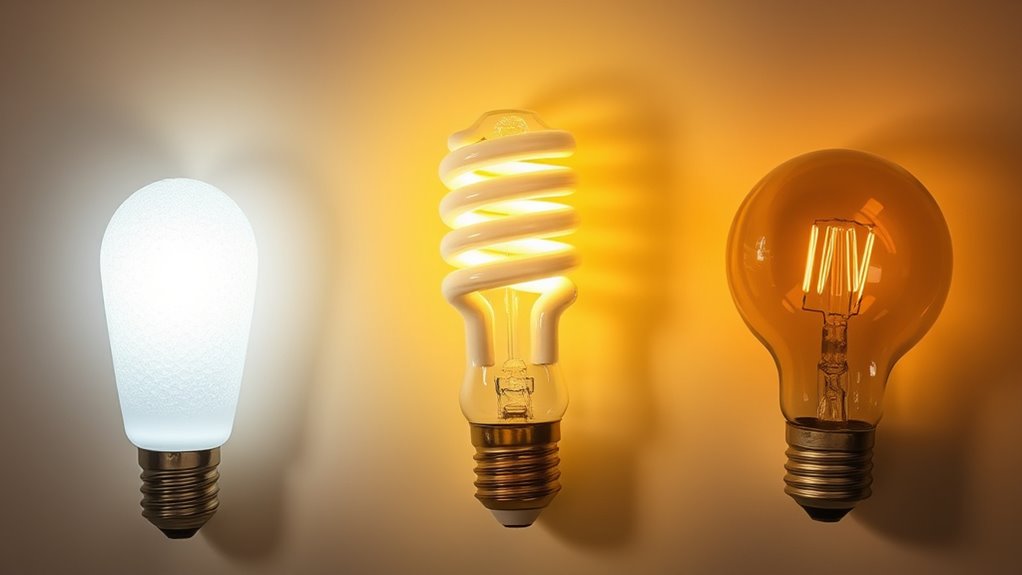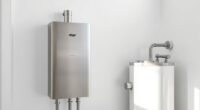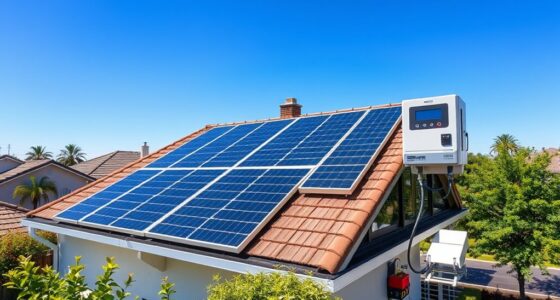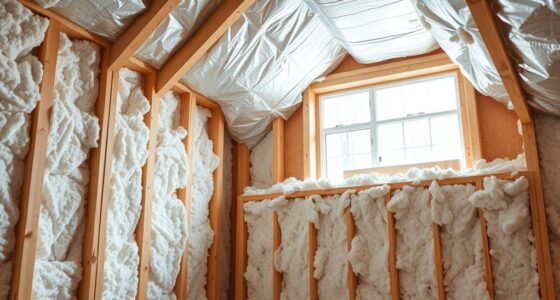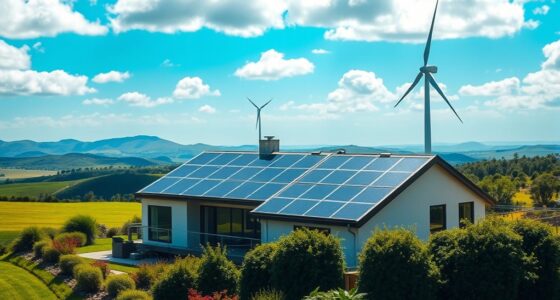When choosing lighting, LEDs are the most energy-efficient, lasting up to 50,000 hours and using considerably less power than incandescent bulbs, which only last about 1,000 hours. CFLs fall in between, offering better efficiency than incandescents but contain mercury, making disposal tricky. LEDs also emit very little heat and are safer to handle. If you want to save money, reduce waste, and choose eco-friendly options, there’s more to explore about each type’s benefits.
Key Takeaways
- LEDs are the most energy-efficient, lasting up to 50,000 hours with minimal heat emission.
- Incandescent bulbs have the shortest lifespan and highest energy consumption, but are the cheapest initially.
- CFLs are more efficient than incandescents but contain mercury, requiring careful disposal.
- Over time, LEDs offer greater cost savings due to lower energy use and fewer replacements.
- LEDs are environmentally friendly, non-toxic, and produce less heat compared to CFLs and incandescents.

Are you unsure which lighting option best suits your needs? Choosing between LEDs, CFLs, and incandescent bulbs can seem overwhelming, but understanding their differences makes it easier to pick the right one. LEDs are the most energy-efficient choice. They use only about 20-25% of the energy that incandescent bulbs consume, saving you money on electricity bills over time. For example, a typical 60W incandescent uses a lot more power than a 7-16W LED that produces the same amount of light. Plus, LEDs last up to 50,000 hours, which means fewer replacements and less waste. In contrast, incandescent bulbs last around 1,000 hours, and CFLs typically last about 10,000 hours.
LEDs are the most energy-efficient lighting option, lasting up to 50,000 hours and saving you money over time.
Heat emission is another important factor. LEDs emit very little heat compared to incandescents and CFLs, which release about 80-90% of their energy as heat. This not only makes LEDs safer to handle and reduces cooling costs but also means they are more environmentally friendly. Incandescent bulbs convert only about 10% of electrical input into light, wasting most energy as heat. CFLs are better in this regard, but they contain mercury, which poses disposal challenges and environmental risks if not handled properly. LEDs are free of toxic materials, making disposal easier and more eco-friendly. Their durability also means fewer replacements, reducing waste and ongoing costs.
When it comes to initial costs, LEDs tend to be more expensive upfront than CFLs or incandescents. However, their long-term savings are substantial. Over 20 years, LEDs cost less overall because they consume less energy, last longer, and require fewer replacements. Many regions also offer rebates for energy-efficient lighting, helping offset the initial expense. Considering cost per hour of use, LEDs are the most economical choice. They produce more lumens per watt compared to incandescents and CFLs, meaning they generate more light with less power. Additionally, the long lifespan of LEDs further enhances their cost-effectiveness and reduces maintenance efforts.
In terms of environmental impact, LEDs are the clear winner. They emit minimal heat, do not contain toxic substances, and have a longer lifespan, which reduces waste. CFLs, with their mercury content, require special disposal and pose environmental risks if broken. Incandescents waste a lot of energy and generate unnecessary heat, making them the least eco-friendly option. Overall, if you’re looking for a lighting choice that combines efficiency, safety, and long-term savings, LEDs are your best bet. They may cost more initially, but their benefits far outweigh the price difference, especially when considering energy savings, durability, and environmental impact.
Frequently Asked Questions
Which Lighting Option Is Most Cost-Effective Long-Term?
You want the most cost-effective lighting option long-term. LEDs are your best choice because, although they cost more upfront, they use less energy, last much longer, and need fewer replacements. Over time, these savings add up considerably. You’ll spend less on energy bills and maintenance, making LEDs a smart investment that pays off in the long run. Their durability and environmental benefits make them the most economical option overall.
How Do LED, CFL, and Incandescent Bulbs Compare Environmentally?
You want to know how LED, CFL, and incandescent bulbs compare environmentally. LEDs use less energy, produce fewer greenhouse gases, and last longer, making them the eco-friendliest option. CFLs contain mercury and contribute more to pollution, though they use less energy than incandescent bulbs. Incandescents are the worst for the environment, given their high energy use and short lifespan. Switching to LEDs helps reduce your carbon footprint and waste.
Are There Health Concerns Associated With CFL Bulbs?
You might be concerned about health risks from CFL bulbs. They emit UV radiation, which can damage your skin and increase eye disease risks like cataracts. Plus, if broken, they release mercury, a toxic substance. To stay safe, handle them carefully, avoid breakage, and consider using UV filters or glasses. Proper disposal is also essential to prevent mercury from harming you or the environment.
Can All Fixtures Support LED or CFL Bulbs?
You might wonder if all fixtures support LED or CFL bulbs. Not every fixture is compatible; check the base type and wattage limits first. For dimmer switches, ensure the bulbs are compatible. Enclosed fixtures can be tricky—LEDs may not work well unless rated for heat. Always verify the fixture’s specifications, and when in doubt, consult the manufacturer to prevent damage or safety hazards.
How Do Lighting Options Impact Home Resale Value?
Ever wondered how lighting can boost your home’s value? Proper outdoor lighting enhances curb appeal, making your home stand out at night and creating a positive first impression. Inside, bright, well-designed lighting makes rooms feel larger and more inviting. Upgrading to energy-efficient options like LEDs not only cuts costs but also attracts eco-conscious buyers. So, strategic lighting investments can markedly increase your resale value and make your home more appealing.
Conclusion
Choosing the right lighting can save you money and energy. Did you know LEDs use up to 75% less energy than incandescent bulbs? They also last 25 times longer, meaning fewer replacements and less waste. CFLs are a good middle ground, but LEDs are the most efficient and eco-friendly option today. Making the switch not only benefits your wallet but also helps protect the environment. So, consider upgrading—you’ll see the difference in both your home and your bills.

